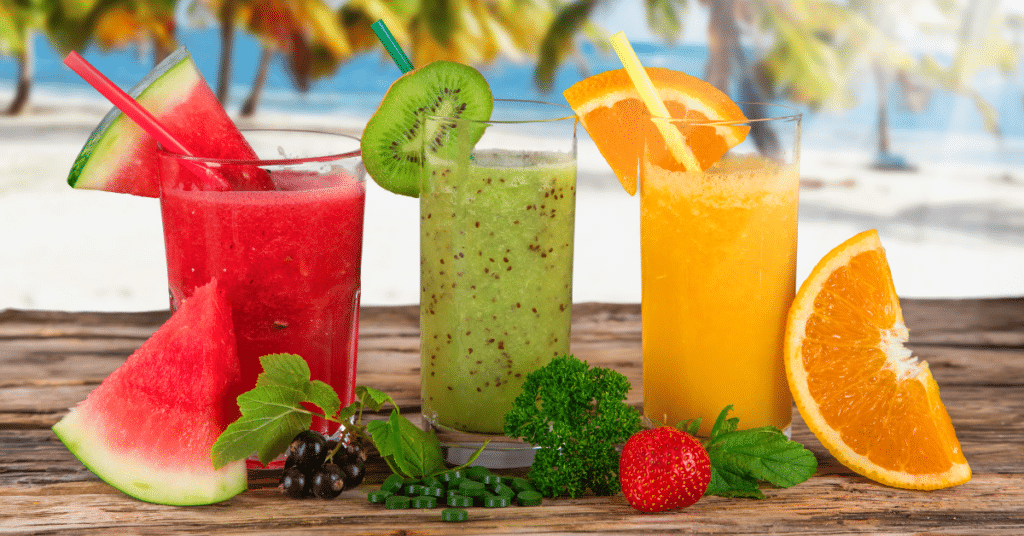This guide covers tummy fat removal effective effective tips for individuals looking to achieve a flatter stomach. Similarly, finding out the best ways to reduce to lose weight. Not to mention how to get rid of tummy fat, both surgical and non-surgical. Furthermore, we will talk about dietary changes, exercises, and specific foods and drinks to avoid (packaged foods). As well as what to include in your diet to get healthy weight and lose belly fat effectively.
Certainly, losing belly fat is a problem for many of us to look healthier and more beautiful. It’s not just about looks but also health benefits and risks. Similarly sheds some light on the types of belly fat loss, risks, and procedures to remove belly fat. Subsequently, touching on the topics of the fastest and easiest ways to remove belly fat. Including exercises and home remedies to flatten the stomach: costs, results, and everything else you need to know.
What is Belly Fat and the Risks
Belly or abdominal fat is of two types: subcutaneous fat and more visceral fat. Subcutaneous abdominal fat is the fat just below the skin, blood vessels, and excess blood vessels. While visceral fat or belly fat is the fat around organs inside the abdominal cavity.
The Problem with Visceral Fat
Visceral body fat is bad for the body because it’s active and causes the body many problems. Eventually, the full body fat leads to heart disease, type 2 diabetes, and some cancers. Although, subcutaneous body fat is about looks. Whereas, visceral body fat is about health.
Health Risks of Belly Fat
-
Inflammation – Visceral fat is an inflammatory marker.
-
Heart Disease – Belly fat is a risk factor for heart disease.
-
Type 2 Diabetes – Belly fat is insulin resistance to type 2 diabetes.
-
Metabolic Syndrome – A condition of high blood pressure and high blood sugar with excess abdominal fat.

Tummy Fat Removal – Surgical and Non-Surgical Methods
What is the procedure to remove Belly fat?
The procedure to remove belly fat depends on how much excess visceral fat your belly fat is. Particularly, your goals of losing weight, health, and preferences for how much fat.
Liposuction – A surgical procedure to remove excess fat from the body, including the abdomen. Small incisions and suction device.
Tummy Tuck (Abdominoplasty) – A surgery to remove fat and tighten skin and abdominal muscles. Especially for excess skin due to weight loss or pregnancy.
CoolSculpting – A non-surgical procedure that freezes and kills fat cells without surgery.
Can Belly Fat Be Permanent?
Fat removed by surgery or non-surgery is permanent. But new fat cells will form after losing fat if you either gain weight or lose body weight again. Moreover, a healthy Healthy lifestyle prevents belly fat from coming back.
Can Fat Be Taken Out from Abdomen?
Yes, surgeons can remove fat based on your waist circumference, size, goals, and health condition. Particularly, by liposuction, Tummy Tuck, and non-surgical CoolSculpting.
How Much to Get Rid of Belly Fat?
Cost of belly fat removal procedure, amount of lost visceral belly fat and abdominal fat amount, and location. However, they vary from individual to individual. Here are the average prices:
-
CoolSculpting – $2,000 – $4,000.
-
Liposuction – $3,000 – $7,000.
-
Tummy Tuck – $6,000 – $10,000.
What is the Best Procedure to Lose Weight Fast?
The best procedure to remove belly fat is:
-
Liposuction – For targeted and localized fat.
-
Tummy Tuck – For skin tightening and fat and muscle removal. However, the combination of liposuction and tummy tuck can give individuals full contouring and fat removal.
-
Mini Tummy Tuck – This less invasive tummy tuck for minor fat and skin.
Can Fat Be Removed During Abdominal Surgery?
Yes, cosmetic surgeons remove most belly fat during abdominal surgery like liposuction and Tummy Tuck. Both consider abdominal and burn belly fat procedures. Usually, surgeons combine them with other abdominal surgeries based on individual aesthetic goals ( if needed). As a result, it improves the abdominal contour due to the burn of belly fat deposits
Is Abdominal Liposuction Worth It?
Abdominal liposuction is worth it if you want to target abdominal fat removal and a flat abdomen. Big results with minimal downtime compared to Tummy Tuck.
Can You Get Rid of Belly Fat Permanently?
Fat cells removed by surgery are permanent. But you can lose fat by losing weight. And need to maintain a healthy body after losing weight, through diet and exercise.
Does Fat Removal Hurt?
Pain varies by procedure. Surgery (liposuction and Tummy Tuck) more pain and downtime. Non-surgery (CoolSculpting) minimal pain and downtime.

Tummy Fat Removal – Alternative Methods
What’s the Quickest and Best Way to Get Rid of Stomach Fat?
Indeed, the quickest way to lose weight is a high-protein diet, aerobic exercise, physical activity, and healthy lifestyle changes.
Increase Fiber – Soluble soluble fiber, full, eat more, lose more weight, less.
Reduce Carbs – Fewer carbs, fewer calories, especially from refined carbs, grains, carbs, grains, carbs, water, weight gain, and bloating.
Caloric Deficit – Eating less dietary fat than your current body composition now needs more fat loss and weight too.
HIIT (High-Intensity Interval Training) – HIIT or cardio burns more calories and elevates metabolism for hours after exercise. In fact, it builds muscle mass strength and increases endurance.
Which Exercise Burns Belly Fat Fast?
Core – Planks, leg raises, and Russian twists.
Muscle Strength – Squats, deadlifts, bench press.
Cardio Exercises – Running, cycling, and swimming.

Can You Get Rid of Belly Fat Without Surgery?
Dietary Changes
-
Caloric Deficit – Eating fewer calories than you burn is key to weight loss.
-
Balanced Diet – A diet rich in whole foods, lean proteins, healthy fats, and plenty of veggies. Evidently, helps reduce belly fat.
Exercise
-
Cardio Workouts – Running, swimming, and cycling are effective in burning calories and overall body fat.
-
Strength Training – Building muscle mass through weight lifting helps boost metabolism and burn fat faster.
Lifestyle Changes
-
Adequate Sleep – Lack of sleep can lead to weight gain including belly fat. Aim for 7-9 hours per night.
-
Stress Management – High stress levels can increase cortisol, a hormone that leads to belly fat accumulation. Yoga and meditation can help manage stress.
These alternative methods have fewer health risks and are cheaper than surgery. As well as sustainable, because lifestyle changes promote long-term health and weight maintenance.
Which Fruits, Veggies, and Fermented Foods Help Melt Away Belly Fat?
Berries – Full of antioxidants, fiber, and vitamins. Have low calories and, high fiber. So you feel full and eat less.
Apples – Contains fiber, vitamin C, and antioxidants. Good for gut health and helps reduce belly fat.
Grapefruit – Packed with vitamin A, vitamin C, and fiber Works as insulin resistance and appetite reduction = belly fat melt.
Leafy Greens – Have sufficient vitamins, minerals, and fiber. Low in calories and high in nutrients. Aids in weight loss.
Cruciferous Veggies – Fiber, vitamins, antioxidants. Help with the digestion and burning belly fat.
Peppers – Jammed packed with vitamin A, vitamin C, and capsaicin. Promotes metabolism, while burning fat.
Yogurt – Protein, calcium, probiotics. Good gut health = less belly fat.
Kimchi – A, B, C, probiotics. Digestion and fat metabolism.
Kombucha – Probiotics, enzymes, organic fatty acids and. Digestion and metabolism.
Equally important, nutrition recommends consuming these high-nutritional foods in moderation. In case of allergies, please avoid certain food that triggers heartburn, stomach acid, acid reflux, and GERD symptoms.
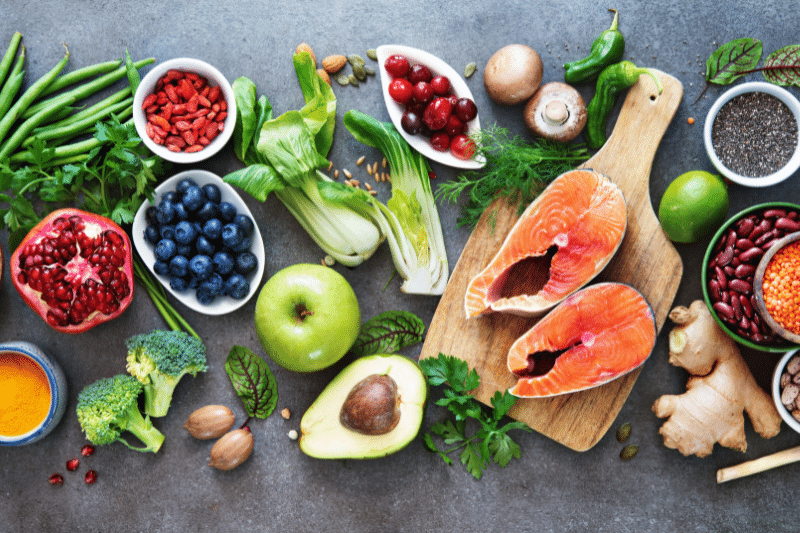
Which Processed Foods to Avoid for Belly Fat?
Sugary Snacks and Beverages
-
Soda and Sugary Drinks – Contain high calories, additives preservatives, and sugar.
-
Candies and Pastries – These are high in sugar, artificial flavor enhancers, and unhealthy fats.
Fast Food
-
Fried Foods – Calorie-dense, bad for health and fattening.
-
Burgers and Fries – High in unhealthy fats, sodium, and calories.
Processed Meats
-
Deli Meats – High in sodium and unhealthy fats.
-
Sausages and Hot Dogs – These are high in saturated fats and preservatives.
Refined Carbohydrates
-
Baked Goods – Made with refined flour and added sugars.
-
White Bread and Pasta – They lack fiber, vitamins, and minerals. Additionally spikes blood sugar.
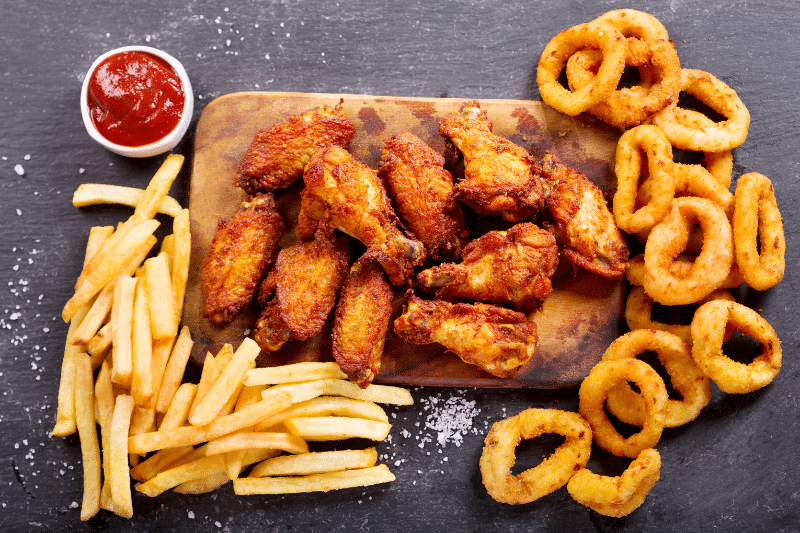
Which Drinks or Beverages to Avoid for Tummy Fat?
Sugary Drinks
-
Sodas are high in sugar and empty calories. On the other hand, fruit juices have tons of added sugars and no fiber.
Alcoholic Drinks
-
Beers are high in calories and promote beer belly. While cocktails or mocktails mixed with sugary syrups and juices. Alcohol and sugary drinks can cause dehydration which slows down metabolism.
Energy Drinks
-
These drinks are high in sugar, caffeine, and artificial ingredients. High sugar content leads to insulin resistance and fat accumulation.
Sweetened Coffee, Lattes, and Tea
Full of artificial flavoring and sweeter syrups. Fattening without nutritional value.
What are the healthier options to reduce tummy fat?
-
Water – Promotes hydration and weight loss.
-
Green Tea – Provides essential antioxidants and boosts metabolism.
Black Coffee – Low calories if no sugar or cream. Although, moderate and long-term consumption has proven beneficial. Including lowering the risk of diabetes, cancer, liver, and cardiovascular diseases.
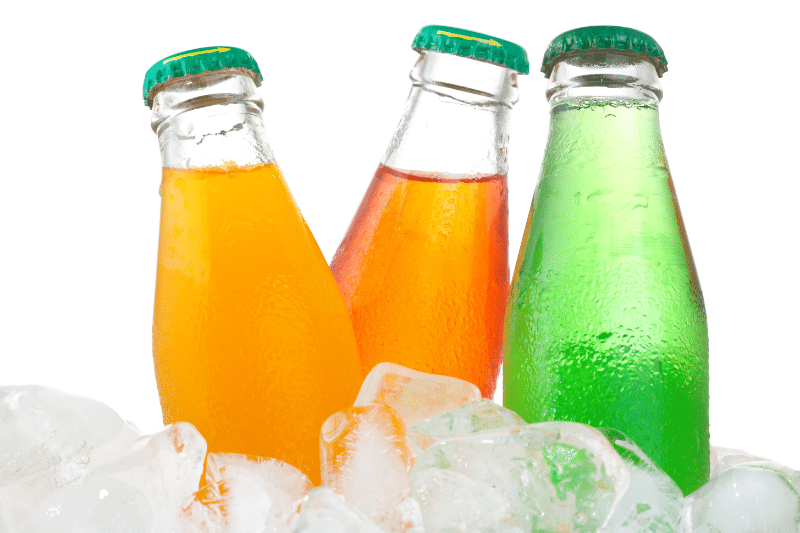
Which Spices to Avoid for Belly Fat?
-
Salt – Excessive salt can cause water retention and bloating. For example, avoid processed foods, canned soups, and snacks.
-
Sugar – Although not a spice in the traditional sense, added sugar in foods and drinks is fattening. Such as consuming less sweets, baked goods, and sugary drinks.
-
High-Calorie Condiments – Some spices and condiments are calorie-dense and add extra calories to meals. For instance, cutting down on barbecue sauce, ketchup with sugar, and creamy salad dressings.
In reality, these spices harm the metabolic health of the body. However, high salt consumption can cause bloating and make belly fat more visible. Whereas, added sugars trans fats, and high-calorie condiments add to overall calorie consumption and fat gain.
Which Spices Are Good to Lose Belly Fat?
-
Cayenne Pepper – High in capsaicin which boosts metabolism. Further, increases calorie burning and reduces appetite.
-
Turmeric – Contains anti-inflammatory curcumin. Nonetheless, reduces inflammation and helps in fat reduction.
-
Cinnamon – Has essential antioxidants with anti-inflammatory properties. In addition. it regulates blood sugar and reduces appetite.
-
Ginger – Gingerol which is anti-inflammatory and antioxidant. Not only aids digestion but also boosts metabolism.
-
Black Pepper – Piperine enhances nutrient absorption. Eventually reduces fat by improving metabolism.
You can use these spices in many ways. Add to meals for flavor and benefits. Use ginger and cinnamon in teas and smoothies. Lastly, you can also use them as supplements, if you can’t add them to your diet.
Which Weight Loss Surgeries Melt Away Tummy Fat?
Liposuction – Removes fat in specific areas. Quick results. Localized fat removal.
Tummy Tuck (Abdominoplasty) – Excess skin and fat removal. Muscle tightening. Flatter, toned belly. Longer recovery. More invasive.
Gastric Bypass Surgery – Smaller stomach. Bypassed small intestine. Weight loss. Obesity-related conditions. Nutrient deficiencies. Lifelong diet changes.
How Long is Recovery for Tummy Fat Removal?
General Recovery
Week 1 – Swelling, bruising, and discomfort. Rest and limited movement only.
Week 2 – Gradually return to light activities. Monitor for any complications.
Month 1 – Most patients can return to normal activities including light exercise.
3-6 Months – Full recovery. The results will be final.
Post Op Care
-
Wound Care – Follow wound cleaning and dressing instructions.
-
Medications – Take prescribed meds for pain and infection.
-
Follow-up – See surgeon for follow-up appointments.
Who is a Good Candidate for Tummy Fat Removal Surgery?
Ideal Candidates
-
Individuals have a stable weight. Especially maintaining the same weight for at least 6 months.
-
Are in overall good health and are non-smokers. Moreover, have no significant medical conditions.
-
Have realistic expectations. Nevertheless, understand the limitations and potential outcomes of the surgery.
-
Have excess fat and skin. Furthermore, localized fat deposits and loose skin that doesn’t respond to diet and exercise.
Non-Ideal Candidates
-
Individuals struggling with unstable Weight. Additionally having significant weight fluctuations.
-
Are in overall poor health. Besides this, have a medical history of being at risk of heart disease, and/or diabetes.
-
Those who are chain smokers. As a matter of fact, smoking can impede healing and increase the risk of complications.
Step-by-Step Procedure Guide for Tummy Fat Removal Surgery
Pre-Operative Preparations
-
Consultation – Firstly, discuss goals, options, and expectations with a qualified surgeon.
-
Medical Evaluation – Secondly, complete a thorough medical assessment, blood tests, and imaging studies.
-
Preparation – Thirdly, follow pre-op instructions, fasting, and avoiding certain medications.
During the Surgery
-
Anesthesia – Fourthly, administered to ensure patient comfort.
-
Incision – Then, the surgeon makes precise incisions in predetermined areas.
-
Fat Removal – Later, the surgeon removes fat using liposuction or excision.
-
Tightening – Additionally, the surgeon tightens the muscles and removes excess skin.
-
Closure – Finally, close the incisions with sutures, staples, or surgical adhesive.
Post-Operative Care
-
Monitoring – Consequently, the medical team monitors the patient in the recovery area for any immediate complications.
-
Dressings – Subsequently, the surgeon applies bandages and recommends compression garments to support healing.
-
Pain Management – Generally, the medical team provides medications for pain and discomfort.
-
Instructions – Lastly, the surgeon provides detailed care instructions for wound care, activity restrictions, and follow-up appointments.
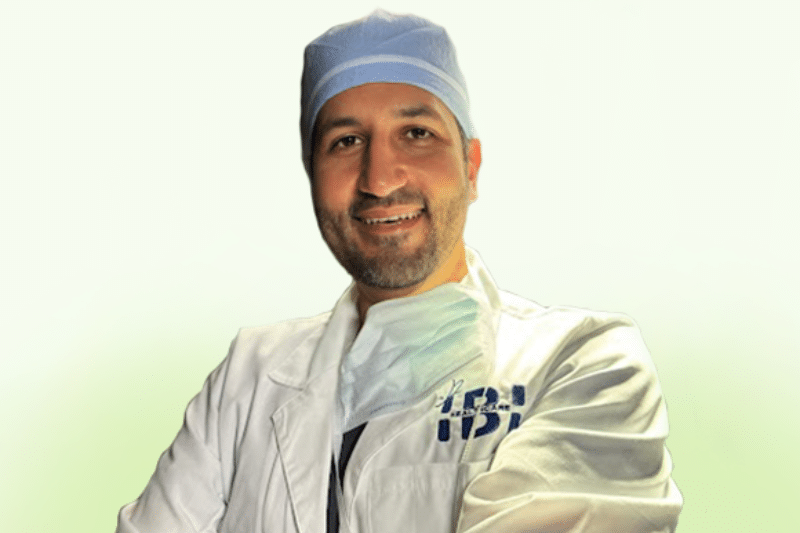
How Do Surgeons Perform Tummy Fat Removal Surgery?
Liposuction
-
Procedure – The surgeon makes small incisions and then inserts the cannula to suction out the fat.
-
Ideal For – Localized fat deposits that don’t respond to diet and exercise.
Tummy Tuck (Abdominoplasty)
-
Procedure – Longer incision, excess skin removed, muscles tightened.
-
Ideal For – Excess skin and weakened abdominal muscles post-pregnancy or weight loss.
Gastric Bypass Surgery
-
Procedure – Creating a small stomach pouch and rerouting the small intestine.
-
Ideal For – Significant weight loss in individuals with obesity.
Combining Procedures
-
Lipoabdominoplasty – Combining liposuction with a tummy tuck for more comprehensive results.
-
Gastric Sleeve with Liposuction – Combining weight loss surgery with targeted fat removal for patients with significant obesity.
Post-Operative Care for Tummy Fat Removal Surgery
Immediate Post-Operative Care
-
Rest – Essential to avoid strain on the surgical site.
-
Hydration – Drink plenty of fluids to aid in recovery.
-
Compression Garments – Worn to reduce swelling and support healing.
-
Nutrition – Follow a healthy diet to support healing and maintain results.
Long-Term Care
-
Activity Restrictions – Avoid strenuous activities and heavy lifting for several weeks.
-
Follow-Up Visits – Regular appointments with the surgeon to monitor progress.
-
Scar Management – Use recommended creams or treatments to minimize scarring.
-
Healthy Lifestyle – Maintain a balanced diet and regular exercise to preserve surgical results.
Regardless of considering surgical or non-surgical procedures? Call us or book a teleconsultation. Our surgeons will consult with you not only that, but we’ll also give you a plan. To live healthy post-op so you have results fast and recover.






